|
|
|
Sort Order |
|
|
|
Items / Page
|
|
|
|
|
|
|
| Srl | Item |
| 1 |
ID:
112437
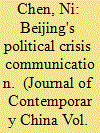

|
|
|
|
|
| Publication |
2012.
|
| Summary/Abstract |
This article explores how the Chinese government managed the 2009 Xinjiang riot through communications. To reconcile Western crisis communication concepts with the Chinese case, this study examines the government communications via news conferences during the riot. It finds that government communication functions only at operational and tactical levels but fails to play a strategic role in crisis management. This is so partly because government public relations have not yet been fully institutionalized. It also notes the differences between the government's handling of a political crisis (the Xinjiang riot) and of a natural disaster (the Sichuan earthquake).
|
|
|
|
|
|
|
|
|
|
|
|
|
|
|
|
| 2 |
ID:
130442
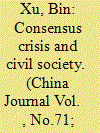

|
|
|
|
|
| Publication |
2014.
|
| Summary/Abstract |
Consensus crisis and civil society: the Sichuan earthquake response and state-society relations
A consensus crisis is characterized by challenges to the state's managerial capacity, a critical need for civil society's services, a general agreement on priorities and goals, and the state's efforts to construct a morally respectable image. These features amplify the structural conditions favorable for relatively amicable state-society interactions. Existing studies of social response to the 2008 Sichuan earthquake focus on state-society relations, but neglect the role of situations. I argue that the earthquake is an example of a consensus crisis, which provided civil associations with a situational opening of political opportunity.
|
|
|
|
|
|
|
|
|
|
|
|
|
|
|
|
| 3 |
ID:
114578
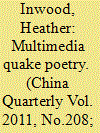

|
|
|
|
|
| Publication |
2011.
|
| Summary/Abstract |
This article examines a wave of Chinese poetry sparked by the 2008 Sichuan earthquake. "Quake Poetry" was published online before being re-circulated through digital, print and live media. Multimedia adaptations of one poem are examined to investigate the relationship between the authors of Quake Poetry, the different media platforms, and the people and institutions involved in its proliferation. Media convergence enabled Quake Poetry to fulfil several functions in the aftermath of the earthquake. Most prominently, it served as an emotional outlet for those affected by the quake, while giving its netizen-producers a sense of creative agency as they engaged in participatory cultural production. Members of the contemporary poetry scene cited Quake Poetry as evidence of poetry's ongoing hold over the Chinese national consciousness. Finally, certain poems were appropriated and promoted by China's state-controlled media to propagate a politically expedient image of Chinese unity in the face of tragedy.
|
|
|
|
|
|
|
|
|
|
|
|
|
|
|
|
| 4 |
ID:
104308
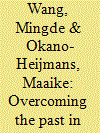

|
|
|
|
|
| Publication |
2011.
|
| Summary/Abstract |
Historical disputes and nationalism continue to be issues of concern and controversy in the relationship between Japan and China. In 2005, popular nationalist sentiment culminated in nationwide anti-Japanese movements in China. This led to a crucial shift in the way China and Japan deal with history and popular nationalism. An unprecedented dialogue on war memory was initiated in late 2006, and the Sichuan earthquake relief effort in mid-2008 marked a further departure from earlier patterns. The Chinese government shifted away from conventional historiography that largely fed negative images of Japan. While these developments point to new, cooperative attitudes that aim to contain popular nationalist sentiment in manageable proportions, relations are nevertheless increasingly obscured by other tensions in the bilateral relationship.
|
|
|
|
|
|
|
|
|
|
|
|
|
|
|
|
| 5 |
ID:
145796
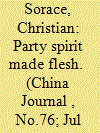

|
|
|
|
|
| Summary/Abstract |
This article argues that the Party retains a tradition of seeking to revitalize its legitimacy through demonstrations of benevolence and glory. The post-2008 Sichuan earthquake provided just such an opportunity to mobilize the discourse of “Party spirit” and display the willingness of cadres to suffer and sacrifice themselves on behalf of the people. In addition to being grist for the propaganda mill, these norms and expectations were implemented in concrete policy directives and work pressures. Local cadres, who were also earthquake survivors, started to suffer from exhaustion, insomnia, and depression. After high-profile suicides by several local cadres, the Party adopted a therapeutic discourse in order to address the psychological needs of individual cadres, though these gentler policies seem doomed to be short-lived.
|
|
|
|
|
|
|
|
|
|
|
|
|
|
|
|
| 6 |
ID:
131640
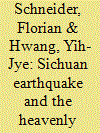

|
|
|
|
|
| Publication |
2014.
|
| Summary/Abstract |
In the aftermath of the 2008 Sichuan earthquake, the Chinese authorities launched a major public relations campaign to relay positive images of their relief effort and strengthen their political legitimacy. The effect has been a proliferation of symbols and political statements related to the disaster, not only in the official media, but also in cultural products such as movies or mass-media events. The earthquake has become part of the discourse of suffering, struggle, solidarity and ultimately victory. This article examines the ways in which various cultural products present the Sichuan earthquake and asks what meanings national crises have in the Chinese discourse on political legitimacy. The article analyses two cases: Chinese film, here in the form of Feng Xiaogang's blockbuster Aftershock, and performance-based discourses during the Beijing Olympics, the PRC's 60-Year Anniversary and the Shanghai Expo. By conducting a discourse analysis, we show how the earthquake has become part of a recurring discursive formation that is used by state and non-state actors alike to legitimate China's developmental model. Within this discourse, the leadership of the Party, the mastery of free markets and a revamped version of the Confucian idea of benevolent rule are marshaled as the decisive factors for winning any 'battle'.
|
|
|
|
|
|
|
|
|
|
|
|
|
|
|
|
| 7 |
ID:
156523
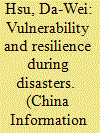

|
|
|
|
|
| Summary/Abstract |
The tendency of previous research on vulnerability and resilience is to measure these two factors as quantifiable variables that vary between social strata and social groups. Past findings often emphasize structural factors, such as inequality and power relations. My fieldwork on survivors of the 2008 Sichuan earthquake complements this paradigm in two steps. First, I display the ‘inter-’ and ‘intra-categorical’ variations of five social categories, each with its own advantages, limits, goals, and difficulties. The resilience of the survivors varies qualitatively and cannot be reduced to a unidimensional scale. Second, I develop a framework of resilience based on the degrees of structure and agency. I identify five modes of resilience: well-integrated, renouncing, activist, defeated, and treading water. This framework can be used to assess the resource distribution of a community, locate people in need and people who can contribute and design proper interventions.
|
|
|
|
|
|
|
|
|
|
|
|
|
|
|
|
|
|
|
|
|